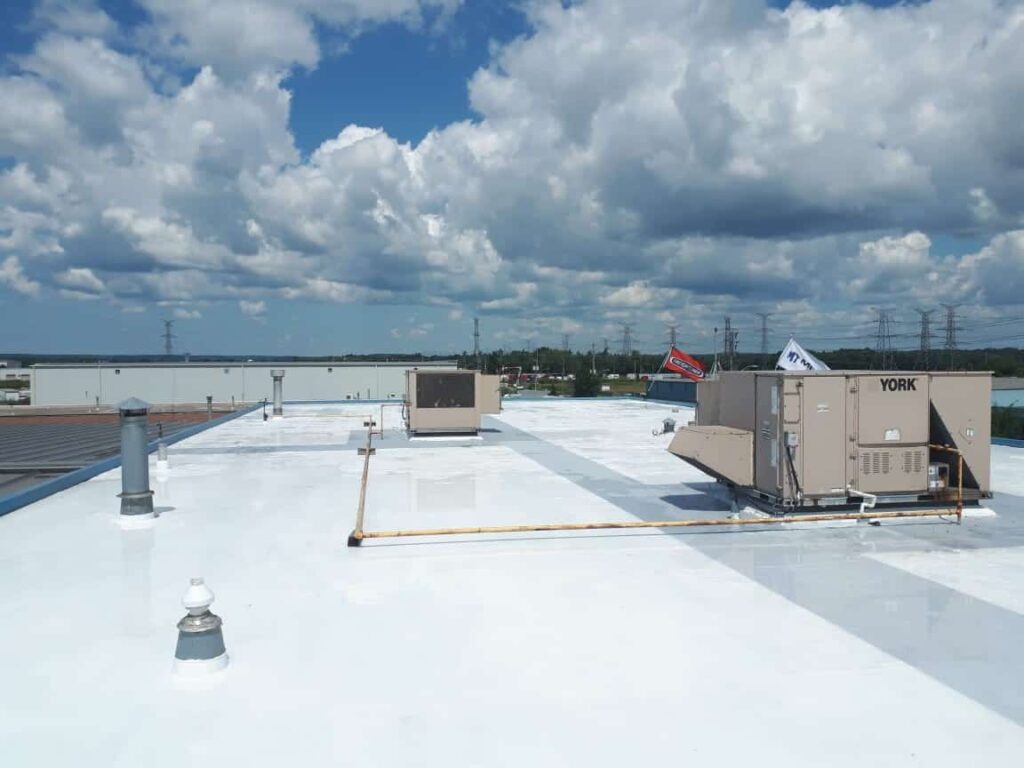There are many different types of roofing systems on the market today. But which one is right for your commercial building or industrial facility? The answer may lie in understanding the difference between cold-applied and hot-applied roofing products.

Hot-applied roof systems are typically made of asphalt/bituminous/tar-based products and are applied hot, or with heat, hence the name. Some of these methods have been used for many years and are time-tested solutions. Cold-applied roof coatings have been utilized over the last 30 years and have increased in popularity over the last decade due to the growing demand to restore, as opposed to remove and replace, older roofs reducing environmental impact and costs. These coatings are usually made of polyurethane, silicone, or acrylic and are applied “cold” at ambient temperature.
Let’s take a closer look at the key differences between these types of roofing systems.
Cold-Applied vs. Hot-Applied Roof Systems
Here’s why cold-applied liquid coatings may be the better roofing solution. If you are unsure which type of roof system is best for your project, consult with a roofing professional. They will be able to assess your needs and recommend the best solution for your particular project.
Application Temperature
One of the main differences between cold-applied and hot-applied roofs is the temperature of the roofing material when it is applied. Cold-applied coatings are at ambient temperature when they are applied, not requiring any heat sources for application. Hot-applied roofing products are either heated to around 300 to 500 degrees Fahrenheit before application, or they require a heat source or torch to adhere to the roof surface and/or seal seams depending on the material used.
Materials Used
The materials used in each type of system also differ. Cold-applied coatings are usually polyurethane, silicone, or acrylic based , while hot-applied coatings like BUR roofs or Torch Down (Mod Bit) roofs generally contain components like asphalt and tar. Single ply heat sealed roofs like PVC, TPO and EPDM are oil and petroleum based with PVC containing the least amount of these products.
Cost
Hot-applied roofing systems are generally more expensive from a labour perspective than the cold applied liquid coatings and the equipment needed for these hot-applied types of applications is generally more expensive as well. Cold-applied liquid coatings fast application minimizes downtime for building owners, and these roofing systems can last anywhere from 10 to 30 years before reapplication is required. For these cold applied coatings reapplication simply means a new layer of topcoat to be applied over the existing liquid roofing system – saving time and money for the property owner in the future as well.
Performance
In general, cold-applied liquid roofing systems have better flexibility and adhesion than hot-applied roofing systems and, in comparison to the single ply roofing systems, can have higher shore hardness and puncture resistance. Polyurethanes are the strongest of the three cold applied coatings discussed here, being the most flexible and most puncture resistant. All three cold applied coatings also resist degradation from ultraviolet (UV) light better than hot-applied coatings.
Polyurethane and silicone coatings will not crack in low temperatures and have better resistance to ponding water than any of the other roofing options. As these roofing systems have no seams (they form one monolithic coating) they are less likely than the other roofing systems to leak. Acrylic coatings also provide a roof with no seams however they do not perform as well with ponding water, they are water based and will degrade when in prolonged contact with water, and they do not perform well in cold weather. Acrylic coatings are more commonly used in warmer climates.
Time Required
Cold applied liquid coatings save a significant amount of time and money, while reducing risks, especially when you are looking at a re-roofing scenario. With these coatings as long as the existing roof is in reasonable condition you can coat directly overtop saving the labour costs, waste disposal costs, environmental impact, and risks, that go hand in hand with removing an existing roof in need of replacement. If it is a new roofing scenario cold applied roofing requires far less time and labour with much less risk than the majority of hot applied methods.
Other Waterproofing Applications for Cold-Applied Liquid Coating Systems
There are various other applications for cold-applied polyurethane and polyurethane-hybrid liquid coating systems such as the waterproofing of:
- Below-grade walls
- Foundations
- Decks & Balconies
- Patios
- Lagoons
- Ponds
- Reservoirs
- Planters
- Secondary containment basins
- Tanks
- Etc.
If you are looking for a waterproofing solution that is safe, easy to use, and durable, then cold-applied liquid coatings are the ideal choice.
Contact IMC Distributors for the Best Liquid Waterproofing Solutions in Canada for Commercial & Industrial Uses
If a waterproofing solution that is quick and easy to apply is required, then cold-applied liquid coatings are a great option. With a wide range of cold-applied coatings available, IMC Distributors can provide you with the ideal solution for your needs.
We are a leading distributor of cold-applied coatings in Canada and have a team of experts who can help you choose the right product for your project. Our line of cold-applied roof coatings from ISOMAT can be rapidly applied as cold-applied liquid waterproofing membranes utilizing a roller or spray to form a monolithic seamless barrier regardless of type or number of protrusions and penetrations on the roof. These include:
- ISOFLEX-PU 500 DTL
- ISOFLEX-PU 500
- ISOFLEX-PU 500 A
- ISOFLEX-PU 560 BT & BTF
- TOPCOAT PU 720
- TOPCOAT PU 740
- TOPCOAT PAS 760
- TOPCOAT PAS 780
For more information about our cold-applied roof coatings, you can explore our various products above or contact us today!
 Karli Logan is the Owner and President of IMC Distributors which is the exclusive partner of Nukote Coating Systems in Canada. With a B.Sc and M.Sc, as well as a demonstrated history of working across a number of industries, she has a passion to drive significant gains and benefits for IMC’s clients.
Karli Logan is the Owner and President of IMC Distributors which is the exclusive partner of Nukote Coating Systems in Canada. With a B.Sc and M.Sc, as well as a demonstrated history of working across a number of industries, she has a passion to drive significant gains and benefits for IMC’s clients.